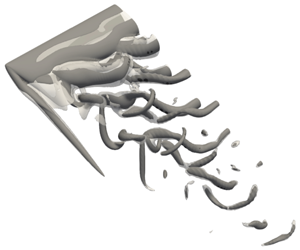Published online by Cambridge University Press: 15 May 2020

We perform direct numerical simulations of flows over unswept finite-aspect-ratio NACA 0015 wings at  $Re=400$ over a range of angles of attack (from
$Re=400$ over a range of angles of attack (from  $0^{\circ }$ to
$0^{\circ }$ to  $30^{\circ }$) and (semi) aspect ratios (from 1 to 6) to characterize the tip effects on separation and wake dynamics. This study focuses on the development of three-dimensional separated flow over the wing. We discuss the flow structures formed on the wing surface as well as in the far-field wake. Vorticity is introduced from the wing surface into the flow in a predominantly two-dimensional manner. The vortex sheet from the wing tip rolls up around the free end to form the tip vortex. At its inception, the tip vortex is weak and its effect is spatially confined. As the flow around the tip separates, the tip effects extend farther in the spanwise direction, generating noticeable three dimensionality in the wake. For low-aspect-ratio wings (
$30^{\circ }$) and (semi) aspect ratios (from 1 to 6) to characterize the tip effects on separation and wake dynamics. This study focuses on the development of three-dimensional separated flow over the wing. We discuss the flow structures formed on the wing surface as well as in the far-field wake. Vorticity is introduced from the wing surface into the flow in a predominantly two-dimensional manner. The vortex sheet from the wing tip rolls up around the free end to form the tip vortex. At its inception, the tip vortex is weak and its effect is spatially confined. As the flow around the tip separates, the tip effects extend farther in the spanwise direction, generating noticeable three dimensionality in the wake. For low-aspect-ratio wings ( $sAR\approx 1$), the wake remains stable due to the strong tip-vortex induced downwash over the entire span. Increasing the aspect ratio allows unsteady vortical flow to emerge away from the tip at sufficiently high angles of attack. These unsteady vortices shed and form closed vortical loops. For higher-aspect-ratio wings (
$sAR\approx 1$), the wake remains stable due to the strong tip-vortex induced downwash over the entire span. Increasing the aspect ratio allows unsteady vortical flow to emerge away from the tip at sufficiently high angles of attack. These unsteady vortices shed and form closed vortical loops. For higher-aspect-ratio wings ( $sAR\gtrsim 4$), the tip effects retard the near-tip shedding process, which desynchronizes from the two-dimensional shedding over the midspan region, yielding vortex dislocation. At high angles of attack, the tip vortex exhibits noticeable undulations due to the strong interaction with the unsteady shedding vortices. The spanwise distribution of force coefficients is found to be related to the three-dimensional wake dynamics and the tip effects. Vortical elements in the wake that are responsible for the generation of lift and drag forces are identified through the force element analysis. We note that at high angles of attack, a stationary vortical structure forms at the leading edge near the tip, giving rise to locally high lift and drag forces. The analysis performed in this paper reveals how the vortical flow around the tip influences the separation physics, the global wake dynamics, and the spanwise force distributions.
$sAR\gtrsim 4$), the tip effects retard the near-tip shedding process, which desynchronizes from the two-dimensional shedding over the midspan region, yielding vortex dislocation. At high angles of attack, the tip vortex exhibits noticeable undulations due to the strong interaction with the unsteady shedding vortices. The spanwise distribution of force coefficients is found to be related to the three-dimensional wake dynamics and the tip effects. Vortical elements in the wake that are responsible for the generation of lift and drag forces are identified through the force element analysis. We note that at high angles of attack, a stationary vortical structure forms at the leading edge near the tip, giving rise to locally high lift and drag forces. The analysis performed in this paper reveals how the vortical flow around the tip influences the separation physics, the global wake dynamics, and the spanwise force distributions.